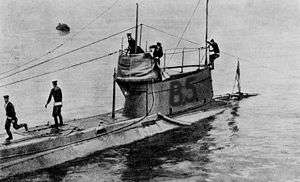HMS B5
HMS B5 was one of 11 B-class submarines built for the Royal Navy in the first decade of the 20th century. She survived World War I and was sold for scrap in 1921.
 | |
| History | |
|---|---|
| Name: | HMS B5 |
| Builder: | Vickers |
| Launched: | 14 November 1905 |
| Completed: | 25 February 1906 |
| Fate: | Sold for scrap, 25 August 1921 |
| General characteristics | |
| Class and type: | B-class submarine |
| Displacement: |
|
| Length: | 142 ft 3 in (43.4 m) |
| Beam: | 12 ft 7 in (3.8 m) |
| Draught: | 11 ft 2 in (3.4 m) |
| Installed power: | |
| Propulsion: |
|
| Speed: |
|
| Range: | 1,000 nmi (1,900 km; 1,200 mi) at 8.7 kn (16.1 km/h; 10.0 mph) on the surface |
| Test depth: | 100 feet (30.5 m) |
| Complement: | 2 officers and 13 ratings |
| Armament: | 2 × 18 in (450 mm) bow torpedo tubes |
Design and description
The B class was an enlarged and improved version of the preceding A class. The submarines had a length of 142 feet 3 inches (43.4 m) overall, a beam of 12 feet 7 inches (3.8 m) and a mean draft of 11 feet 2 inches (3.4 m). They displaced 287 long tons (292 t) on the surface and 316 long tons (321 t) submerged. The B-class submarines had a crew of two officers and thirteen ratings.[1]
For surface running, the boats were powered by a single 16-cylinder 600-brake-horsepower (447 kW) Vickers petrol engine that drove one propeller shaft. When submerged the propeller was driven by a 180-horsepower (134 kW) electric motor. They could reach 12 knots (22 km/h; 14 mph) on the surface and 6.5 knots (12.0 km/h; 7.5 mph) underwater.[1] On the surface, the B class had a range of 1,000 nautical miles (1,900 km; 1,200 mi) at 8.7 knots (16.1 km/h; 10.0 mph).[2]
The boats were armed with two 18-inch (450 mm) torpedo tubes in the bow. They could carry a pair of reload torpedoes, but generally did not as they would have to remove an equal weight of fuel in compensation.[3]
Construction and career
B5 was built by Vickers at their Barrow-in-Furness shipyard, launched 14 November 1905 and completed 25 February 1906. When the war began in 1914, the boat was assigned to defend the Straits of Dover. B5 was sold on 25 August 1921 to AJ Anderson, then sold again on 1 March 1922 to J Smith, Poole.
Notes
- Gardiner & Gray, p. 87
- Akermann, p. 123
- Harrison, Chapter 27
References
- Akermann, Paul (2002). Encyclopaedia of British Submarines 1901–1955 (reprint of the 1989 ed.). Penzance, Cornwall: Periscope Publishing. ISBN 1-904381-05-7.
- Gardiner, Robert & Gray, Randal, eds. (1985). Conway's All the World's Fighting Ships: 1906–1921. Annapolis, Maryland: Naval Institute Press. ISBN 0-85177-245-5.
- Harrison, A. N. (January 1979). "The Development of HM Submarines From Holland No. 1 (1901) to Porpoise (1930) (BR3043)". United Kingdom Ministry of Defence. Retrieved 16 September 2019 – via Submariners Association: Barrow in Furness Branch.
- Kemp, Paul & Jung, Peter (1989). "Five Broken Down B Boats: British Submarine Operations in the Northern Adriatic 1915–1917". Warship International. XXVI (1): 10–29. ISSN 0043-0374.
- Wilson, Michael (1981). "The British 'B' Class Submarine". In Roberts, John (ed.). Warship Volume V. London: Conway Maritime Press. pp. 38–44, 74–79. ISBN 0-85177-244-7.